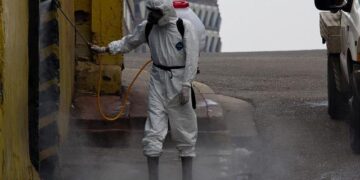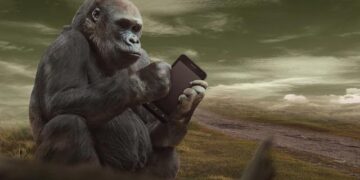More than 50 years after Bob Paine’s experiment with starfish, hundreds of species have been pronounced “keystones” in their ecosystems. Has the powerful metaphor lost its mathematical meaning?

In the late 1960s, Bob Paine described the Pisaster sea star as a “keystone species” in Pacific Northwest tide pools. The concept has since taken on a life of its own.
Julian Nieman/Alamy Stock Photo
Introduction
Anne Salomon’s first week as a graduate student in 2001 was not what she had anticipated. While other new students headed to introductory lectures, Salomon was whisked away by van and then motorboat to Tatoosh Island, which sits just offshore of the northwestern tip of Washington’s Olympic Peninsula. Among the tide pools of this isolated island, Salomon peered at the web of life on the rocks: ochre sea stars, barnacles, mussels, snails and assorted algae that took forms reminiscent of lettuce, moss and bubble wrap.
A visit to this wave-pummeled outcrop was a rite of passage for lab associates of Bob Paine. Decades earlier, Paine, armed with a crowbar, had first pried purple Pisaster starfish — the ecosystem’s top predator — from tide pools in nearby Makah Bay and flung them into the sea so he could learn what forces organized the community of rock-clinging creatures. The results would profoundly influence ecology, conservation and the public perception of nature. After three years without starfish, the 15 species originally present in the pools declined to eight. After 10 years, a mussel monoculture dominated the shore.
The results of Paine’s experiment, published in The American Naturalist in 1966, showed that a single species can have an outsize influence on an ecological community. When Paine shared his findings with the paleoecologist and conservationist Estella Leopold, she suggested that a powerful concept deserved an evocative name. In a subsequent paper, he designated the Pisaster starfish a “keystone species,” referring to an architectural keystone: the wedge-shaped stone atop an arch that, once inserted, prevents the structure from collapsing. “Bob had a fairly poetic, narrative mind,” said Mary Power, an emeritus professor at the University of California, Berkeley who studied under Paine. (Paine died in 2016.)
Salomon, Power and other Paine students dedicated their graduate work to refining the keystone concept and defining a species’ ecological “keystone-ness” mathematically. But like starfish glomming onto rocks, the metaphor took hold in the scientific and public imagination. Many ecologists and conservationists lost sight of the original significance Paine had given to the term and began branding seemingly every important species a keystone. Indeed, an analysis published last year found that over 200 species have been marked as keystones. Usage of the label has become so broad that some ecologists fear that it has lost all meaning.

Bob Paine stands in the intertidal zone of the Pacific Northwest, where he studied how purple starfish structured tide pool communities. In one of his final papers, Paine suggested that humans are a “hyperkeystone” species that exerts ecological influence over all other keystones.
Kevin Schafer/Alamy
Introduction
Ecologists today are working to refine what “keystone species” means and advocate for a more discerning application. With a more rigorous identification of keystone species, policymakers can better identify and safeguard species that have disproportionate impacts on ecosystems, they argue. And new applications in microbial medicine could help biologists more precisely quantify the influence of a keystone species, which could benefit not just ecosystems but human health too.
Species Essentiality
In the decades before Paine conducted his now-famous experiment, ecologists had converged on the theory that species sharing a habitat were connected in a pyramidal network of who eats whom. At the top were rare predators, which ate minor predators or herbivores, which themselves consumed abundant “producers” like plants or algae, which were nourished directly by sunlight and photosynthesis. The web’s stability, ecologists thought, was controlled from the bottom up by the availability of producers.
But by the 1960s, that thinking was changing. Could communities also be strongly influenced by predators? Maybe vegetation dominated ecosystems not because producers limited other species, but because predators prevented herbivores from overgrazing. Paine’s experiment was one of the first to convincingly demonstrate such top-down control in real time.
Then the ecologist James Estes documented how sea otters in California’s offshore kelp forests played a keystone role akin to that of starfish in Paine’s tide pools. In a 1974 paper published in Science, he described how the sea otter, a single predatory species, structured the diversity of the kelp-forest community. Sea otters kept herbivorous sea urchins in check; without the predators, urchins overgrazed and wiped out the entire suite of kelp-dependent species.
These studies and the keystone idea came to prominence at the same moment that America’s environmental conscience was emerging. In 1973, Congress passed the Endangered Species Act, which took a species-focused approach to conserving wildlife. The idea that restoring the population of a single species — a keystone, perhaps — could ensure the biodiversity of an ecological community aligned with this new legal framework.
As a result, the keystone-species concept took on a life of its own. Scientists and conservationists increasingly applied the term to any species considered important, mischaracterizing Paine’s original idea. Top predators like wolves and sharks whose absence had drastic trickle-down impacts were demonstrably keystones. So were habitat-altering ecosystem engineers like beavers, woodpeckers, bison and prairie dogs. But before long there were also scientific references to keystone herbivores, keystone plants, keystone pollinators, even keystone pathogens. Groups of species considered important were labeled “keystone guilds.”
As the term’s mainstream popularity took off, ecologists quietly worked on a mathematical definition of relationships between the species nodes in an ecological network. On Tatoosh Island, Paine’s students continued to examine tide pools, adding or deleting species to see which ones mattered most to the community. Taking careful measurements over many years, they quantified the relative capacity of each grazer to influence baby kelp’s ability to take root — a measurement Paine called “per capita interaction strength,” and which later became known as “keystone-ness.” If an organism had high keystone-ness, each individual had a disproportionately large effect on its ecosystem.
However, most people weren’t following this new ecological math. By the 1990s, some ecologists had become alarmed that overuse of “keystone species” was transforming and diminishing the concept’s meaning. It was time to hash it out. In December 1994, a small conference of ecologists — some self-identifying as “keystone cops” — was held in Hilo, Hawai‘i, to develop a consensus definition. Following Paine and Power’s math, they agreed that “a keystone species is a species whose impacts on its community or ecosystem are large, and much larger than would be expected from its abundance.”

The ecologist Anne Salomon, who became “father-daughter close” with Paine as academic collaborators, studied intertidal communities in Alaska and demonstrated that chiton mollusks are a keystone species there.
Brandy Yanchyk
Introduction
Under this definition, salmon are not a keystone species even though they are ecologically important. “If you take one individual salmon out of a river, it’s not going to have a huge effect,” Salomon said. In contrast, if you take one sea star out of a chunk of an intertidal zone, “it’s going to have a big effect.”
The Hilo convention was a worthy effort. But it didn’t stop researchers from naming new keystones in the decades that followed. “The problem is that there are no standards to which researchers are held in designating their study organism as a keystone,” said Bruce Menge, a community ecologist at Oregon State University and another former Paine graduate student. “Anyone is free to suggest, argue or speculate that their species is a keystone.” And indeed, a new analysis recently revealed just how far the concept has stretched.
We’re All Keystones Here
In 2021, Ishana Shukla was a graduate student at the University of Victoria looking to analyze traits of keystone species. “I quite naïvely thought you could just Google a list of keystone species and a lovely list would come up,” she said. When she couldn’t find one, she thought she’d create her own. She mined more than 50 years of published data, encompassing 157 studies, and identified 230 species considered keystones. She saw that as ecological knowledge advanced, “the function of the keystone started to expand wider and wider.”
Using an analytical technique that organizes items into related clusters, she and her co-authors found five types of keystone species: large vertebrate carnivores like sharks and wolves; invertebrate munchers like the long-spined sea urchin and cabbage butterfly; middle-of-the-pack species that are both predatory and preyed on, such as bream and bullhead fish; invertebrates that perform vital roles in food webs like northern shrimp and honeybees; and small mammals that modify habitats like the ice rat and black-tailed prairie dog.
“We’ve identified a whole swath of keystones that aren’t necessarily getting conservation action or conservation attention, but we can see that they are massively important to our ecosystem,” said Shukla, now a doctoral student at the University of California, Davis.
“The most important message from this paper was that keystone species are not all the same,” said Diane Srivastava, a community ecologist at the University of British Columbia who, while working in Costa Rica, identified damselfly larvae as keystone species in water pooled inside bromeliad leaves. “The public perception of a keystone species is that they are the large terrestrial mammals … but actually, most of them are not. Most keystone species are aquatic. Many of them are not predators. There’s a good number of invertebrates.”
However, the paper didn’t try to evaluate whether these species were true mathematical keystones or not. Instead, Menge said, Shukla and her collaborators merely summarized how the term has been used and misused. In that way the research emphasized, rather than complicated, “continued liberal use of the term ‘keystone species’ to refer to any strong interactor that has indirect consequences,” he said.
None of Shukla’s categories included microbes. Indeed, Paine and others were not thinking about microorganisms at all in their experiments. And yet quantifying keystone-ness has become the subject of a novel line of research in medical microbiology.

A new analysis showed the diversity of organisms that ecologists have named ‘keystones’ in their ecosystems. Top to bottom: Large, animal-eating vertebrates, such as the sea otter; invertebrates that shape their environments, such as the honey bee; midsize vertebrates that consume plant-eaters, such as bullhead fish; and smaller, plant-eating invertebrates, such as the cabbage butterfly.
Top to bottom: GomezDavid/iStock; Dustin Humes; Andyworks/iStock; Wirestock/iStock
A new analysis showed the diversity of organisms that ecologists have named ‘keystones’ in their ecosystems. Clockwise from upper left: Large, animal-eating vertebrates, such as the sea otter; invertebrates that shape their environments, such as the honey bee; midsize vertebrates that consume plant-eaters, such as bullhead fish; and smaller, plant-eating invertebrates, such as the cabbage butterfly.
Clockwise from top left: GomezDavid/iStock; Dustin Humes; Andyworks/iStock; Wirestock/iStock
Introduction
The Keystone in Your Gut
Microbiomes involve hundreds to thousands of microbial species interacting in a complex ecosystem. So why shouldn’t they have keystone species too?
“Presumably, if there’s a keystone species, then the system might be quite fragile,” said Yang-Yu Liu, who studies the microbiome at Brigham and Women’s Hospital and Harvard Medical School. For example, if antibiotics killed off your gut’s keystone microbe, the microbial ecosystem might collapse and cause health complications. “That’s why I’m interested in identifying keystone species from microbial communities,” he said.
It’s not technically or ethically possible to remove species in human microbiomes one by one, the way you might pluck starfish off rocks. Instead, Liu and his colleagues turned to AI in a paper published in November in Nature Ecology & Evolution. Using data from gut, oral, soil and coral microbiome databases, they trained a deep learning model to rank the importance of species in microbial communities by looking at what happened to the community after each species was removed from its model microbiome — essentially quantifying the keystone-ness of each microbe.
In Liu’s analysis, “we didn’t find any species with very large keystone-ness,” he said. The highest calculated value was around 0.2. With their definition of keystone-ness ranging between zero and 1, “0.2 is really not a big number,” he said.
That doesn’t mean there aren’t keystones in microbial communities. Liu believes that these communities have very high levels of functional redundancy — meaning that multiple species may perform similar ecological roles and could therefore be interchangeable. And some species may have high keystone-ness not in an absolute sense but relative to a given person’s microbiome, which is highly personalized. “Those species are quite important in the sense that if you remove them, the system might change a lot,” Liu said.

Yang-Yu Liu and postdocs Zheng Sun and Xu-Wen Wang recently used AI to characterize keystone species in gut, oral, soil and coral microbiomes. “If there’s a keystone species, then the system might be quite fragile,” Liu said.
Xiaole Yin
Introduction
In that sense, in microbial communities, the keystone species concept is context-dependent. A keystone in one microbiome might not be a keystone in another. “I feel that this aspect has not been highly appreciated by ecologists,” Liu said.
Ecologists are now grappling with this contextual nature of keystone species beyond microbes and pondering whether, and how, the concept matters amid the reality of biodiversity loss.
Reassessing the Metaphor
Menge has dedicated his career to understanding ecological community structure, continuing the emphasis on rocky shores from his graduate work with Paine. He’s found that Paine’s iconic purple star isn’t a keystone species everywhere. It has stronger keystone-ness in some places, for example in tide pools more intensely beaten by waves. “In fact, in more sheltered places, the sea star isn’t really much of a keystone at all,” he said.
Paine came to accept this too. Up in Alaska, where the mussel preferred by more southern purple stars is absent, the predator is “just another sea star,” Power recalled Paine saying.
The fact that keystone species are context-dependent and that they vary in space and time is “missed in short-term studies,” Menge said.
Still, Srivastava isn’t ready to discard the concept. While the focus on keystones and single species may have distracted policymakers and conservationists from more holistic approaches to conservation, protecting and restoring a single species can sometimes benefit many other species in an ecosystem. “It doesn’t mean we rush to save keystone species and ignore the diversity of the system as a whole,” she said.
Srivastava also emphasized that keystones are not the only way systems are stabilized. “Ecologists now think that some of the most important interactions in terms of stability are actually relatively weak interactions,” she said. “If you have a high number of species that are weakly interacting, it’s kind of like having a lot of tent pegs tying down your tent in a windstorm. It dissipates some of the perturbations.”
Menge largely agrees. Amid a global loss of species, the main focus should be protecting habitats and biodiversity, not individual species, he said. “If those two things were done in enough places, then I’m not sure that the keystone-species idea is all that critical.”
Maybe one keystone matters more than the rest. In one of Paine’s final papers, published in 2016 on the day of his death, he and ecologist Boris Worm proposed that humans are a “hyperkeystone species” — one that exerts profound effects through exploitation of other keystones.
Humans can’t be removed from the system like starfish to quantify our impact. But we can learn how to reduce our keystone-ness through effective conservation practice and policy, Salomon said. “We also have the ability to learn to steward ourselves.”
That’s one reason why ecologists continue to redefine and reconsider keystone species. The powerful symbol isn’t going anywhere, but with an improved definition, people could learn how to apply it better.
Paine knew this. Salomon likes to share his words with her students: “You can’t manage out of ignorance. You have to know what species do, whom they eat, what role these prey species play. When you know that, you can make some intelligent decisions.”
Next article
AI Starts to Sift Through String Theory’s Near-Endless Possibilities
>>> Read full article>>>
Copyright for syndicated content belongs to the linked Source : Quanta Magazine – https://www.quantamagazine.org/ecologists-struggle-to-get-a-grip-on-keystone-species-20240424/































